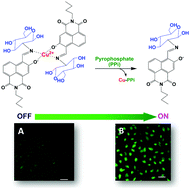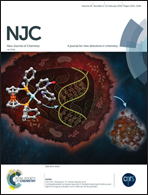A novel glucosamine-linked fluorescent chemosensor for the detection of pyrophosphate in an aqueous medium and live cells†
Abstract
There is growing interest in monitoring the level of pyrophosphate (PPi) in biological processes due to its significant roles in live organisms. In this paper, we described a Cu2+ ensemble based chemosensor (GN-Cu2+) for highly selective detection of PPi in an aqueous medium and live cells. The fluorescence silent ensemble, GN-Cu2+, was facilely prepared by complexing of the glucosamine-1,8-naphthalimide fluorescent ligand (GN) with paramagnetic Cu2+. The structure of GN was confirmed using 1H NMR, 13C NMR and high-resolution mass spectroscopy (HRMS) assays. The spectroscopic characteristics of GN-Cu2+ were verified in detail through fluorescence emission and UV-vis spectra titration. The decomplexation of GN-Cu2+ by PPi led to the liberation of the fluorescent ligand, GN, and thus the fluorescence was switched on. Spectroscopic studies revealed that GN-Cu2+ possesses excellent tolerance to various anions and even other phosphate series, such as AMP, ADP, ATP, and inorganic phosphate (Pi). The detection limit for PPi was calculated to be 1.0 μM. GN-Cu2+ features several advantages, such as high selectivity, reliability at physiological pH and low cytotoxicity. Intracellular fluorescence imaging measurements indicated that GN-Cu2+ is cell membrane permeable and has been successfully used for the detection of PPi in live MD-AMB-231 cells.



 Please wait while we load your content...
Please wait while we load your content...